Carbon Accounting Software for Fashion
Switch from consultants to a fully transparent,
automated carbon accounting platform.

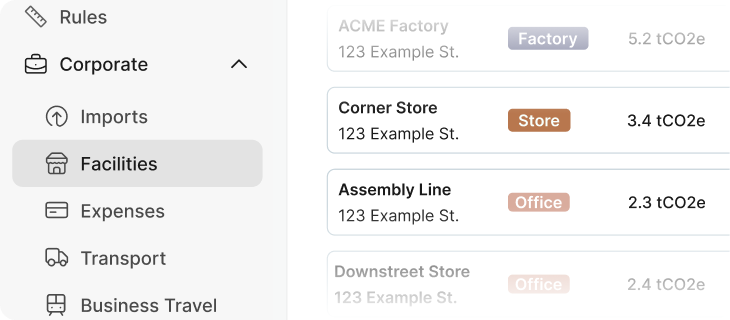
Centralize all GHG emissions in one place
Track all emissions across Scope 1, 2, and 3, including energy, logistics, packaging, travel, purchased goods and more.
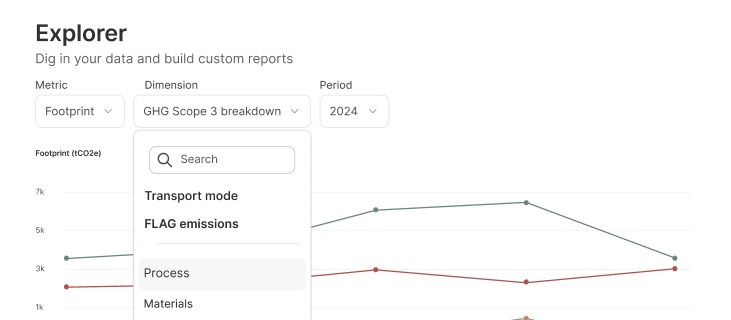
Pinpoint where to act
See insights by scope, material, process, or facility. Visualize footprint trends and identify hotspots across business units.
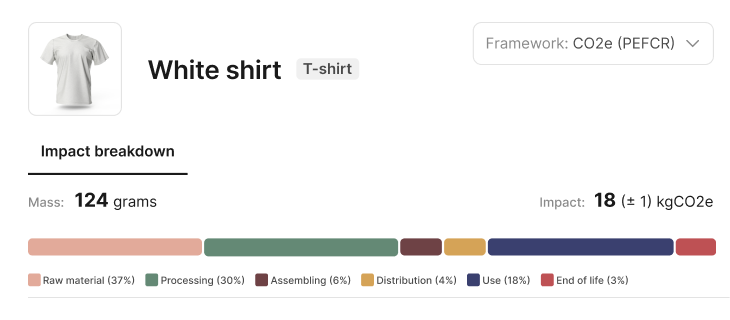
More accurate Scope 3.1
Add representative products to model Scope 3.1. Access LCA insights and generate Digital Product Passports in one click.
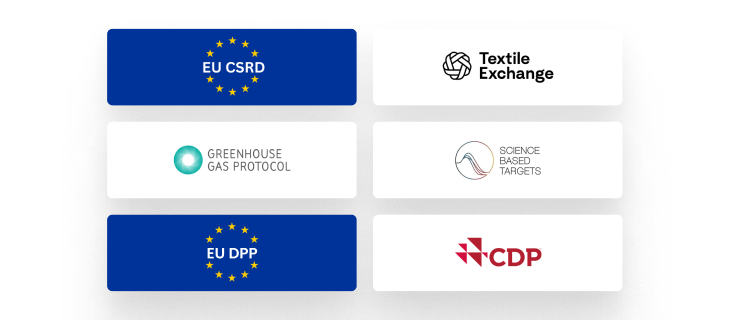
Create audit-ready reports instantly
Get audit-ready reports aligned with the GHG Protocol, CSRD, CDP, BCI, and more – automatically updated.

Upload your data — we handle the rest
Use guided templates or connect your PLM/ERP to import data. We auto-clean, map, and enrich missing values – no data team needed.

Centralize all GHG emissions in one place
Track all emissions across Scope 1, 2, and 3, including energy, logistics, packaging, travel, purchased goods and more.

Pinpoint where to act
See insights by scope, material, process, or facility. Visualize footprint trends and identify hotspots across business units.

More accurate Scope 3.1
Add representative products to model Scope 3.1. Access LCA insights and generate Digital Product Passports in one click.

Create audit-ready reports instantly
Get audit-ready reports aligned with the GHG Protocol, CSRD, CDP, BCI, and more – automatically updated.

Upload your data — we handle the rest
Use guided templates or connect your PLM/ERP to import data. We auto-clean, map, and enrich missing values – no data team needed.
CHOSEN by Hundreds of BRANDS AND SUPPLIERS
Take Control of Your Corporate Emissions
Carbon Accounting Software built for apparel, fashion, textile and footwear
Accurate data, tailored to your supply chain
150K+ fashion-and region-specific emission factors ensure accurate results – even when your data isn’t perfect.
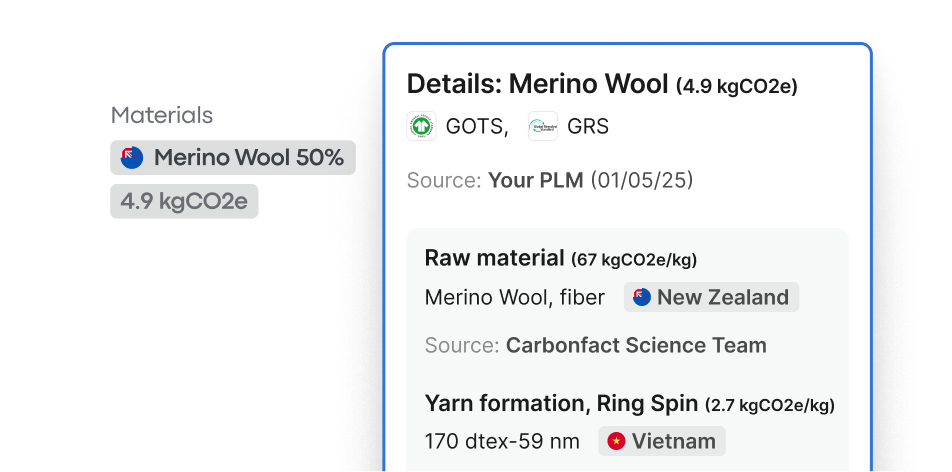
Easy to use, fast results
Upload bills and products with ease – our guided flow gets you set up fast and keeps you in control of your timeline.

Transparent calculations, audit-ready
View the source, method, and emission factor behind every calculation. Aligned with GHG Protocol and reviewed by PwC.
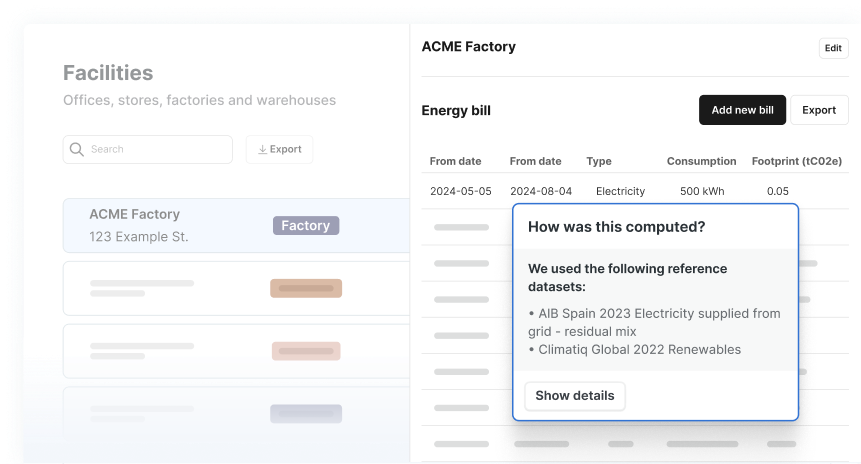
Clean and complete data – without the manual work
We fill missing values using T1–T5 supplier data, verified through running over 50 million apparel and footwear LCAs.
![Link [card-3]-1](https://www.carbonfact.com/hs-fs/hubfs/Link%20%5Bcard-3%5D-1.png?width=1016&height=571&name=Link%20%5Bcard-3%5D-1.png)
Security and compliance
Audit-ready numbers you can trust and communicate.

GHG protocol
Carbon Accounting aligned with the leading standard.

EU PEFCR
Meets EU standards for product-level disclosure.

SOC 2 certified
Enterprise data security, availability & confidentiality.

ISO 14040-44
Methodology independently reviewed by PwC.
Easy data upload, fast results
Upload bills and products with ease – our AI-Importer keeps you in control of your timeline.
Flexible Data Ingestion
We make it easy to get started — even with scattered data. Carbonfact ingests energy bill, facility information, product data, BOMs, care labels, purchase orders, supplier information, and factory data in whatever format you already use. Many brands start with simple Excel exports, then move to custom connectors and live integrations with their PLMs, ERPs, data warehouses for automatic updates.

Automatic Data Cleaning
Carbonfact’s AI Copilot automatically cleans and structures your data — fixing typos, parsing care labels and BOMs, and converting everything into consistent units. We map your diverse data to our taxonomy so everything is standardized. The AI Copilot also spots anomalies (like a T-shirt listed at 10 kilos) and fixes the data. The result: clean, reliable, audit-ready data you can trust.

Smart Data Enrichment
Gaps and errors in your data are normal — and that’s where Carbonfact adds value. We use heuristics — smart estimates trained on Carbonfact’s dataset (e.g. missing d-tex or weights) and rules — information you know but that isn’t stored in your systems (e.g. this supplier always uses recycled packaging). We enrich this further with global emission factor libraries and bespoke factors for unique materials and processes. The source of every data point is transparent and flagged, giving you a complete, consistent dataset you can trust.
Human Quality Ensurance
While our platform handles the heavy lifting, our team of engineers, climate, compliance, and data experts is checking your Carbon Accounting reports for your 💪.

What Our Customers Say


“To make sure we’re capturing every part of garment production, we kicked off a partnership with Carbonfact, our new carbon accounting partner, and recalculated our entire carbon footprint all the way back to our 2021 baseline.”


“Carbonfact provided exactly the kind of feasible solution we needed as a small brand tackling PEF and carbon accounting. With so many automated processes and deep expertise that helped fill in our data gaps, it allowed us to overcome our limited internal capacities while still achieving highly transparent results. This has helped us share more meaningful impact data with our customers — and we’re excited to take the next step together with the upcoming DPP release!”

A Platform to Evolve With
From carbon accounting to compliance to decarbonization — all in one place
Carbon Accounting
Switch from consultants to fully transparent, fashion-specific carbon accounting.
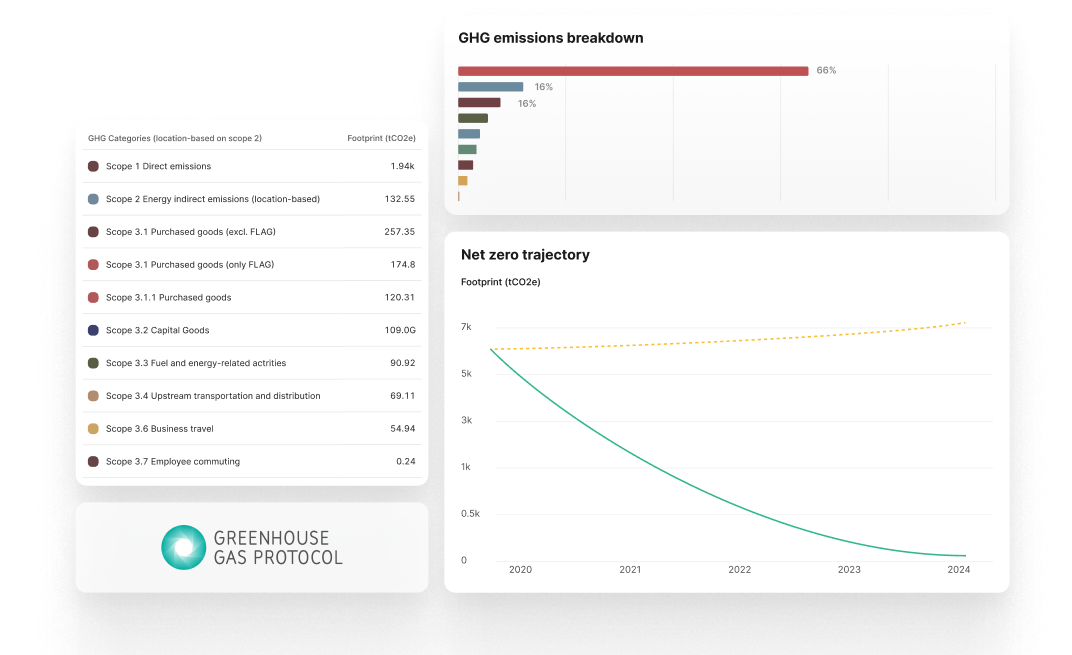
Decarbonization
Model product and company-wide reduction scenarios using your real data.
Reporting
Simplify compliance with automated, audit-ready reports.
Product LCAs
LCAs across your full catalogue – powered by primary data.
Data Management
Connect your systems – we’ll clean, map, and enrich your data.
A Platform to Evolve With
From carbon accounting to compliance to decarbonization — all in one place
Carbon Accounting
Switch from consultants to fully transparent, fashion-specific carbon accounting.

Decarbonization
Model product and company-wide reduction scenarios using your real data.
Reporting
Simplify compliance with automated, audit-ready reports.
Product LCAs
LCAs across your full catalogue – powered by primary data.
Data Management
Connect your systems – we’ll clean, map, and enrich your data.

Expert Support at Every Step
Hands-on support so you can focus on reduction, not data admin.
Dedicated Onboarding & Customer Success Manager
Access to Data & Climate Science experts
Access to the Carbonfact Collective – a peer network of suppliers and brands
Get Started with Fashion-Specific Carbon Accounting
Solutions for first-timers and frontrunners
Frequently Asked Questions
What is carbon accounting in the apparel and footwear industry?
Carbon accounting measures greenhouse gas emissions across every stage of a product's lifecycle — from raw material sourcing to production, transportation, and disposal. For fashion brands, it provides insights into which parts of the supply chain are most carbon-intensive, enabling targeted sustainability efforts.
Why should I switch from a Carbon Accounting consultant to a fashion-specific Carbon Accounting software?
- Fashion-specific carbon footprint platforms like Carbonfact automate data collection, fill data gaps, and generate audit-ready reports—saving you significant time versus consultants.
- You gain full control and transparency, with real-time results, granular fashion-specific accuracy, and detailed Scope 3 insights.
- Easily scale from basic carbon accounting to product LCAs and regulatory reports (CSRD, SBTi, DPP) as your needs grow—no switching platforms needed.
- Lower costs, seamless integrations, and ongoing expert support help you decarbonize efficiently and future-proof your compliance and sustainability work.
How does Carbonfact measure Scope 3.1?
We offer two ways to calculate your Scope 3.1 (Purchased Goods and Services), depending on your data maturity, and needs for granularity. Many fashion brands start with 1) and move later to 2).
1) Representative Products Method (Activity-Based)
- Brands add representative products to model their product mix. Each product includes material composition, weight, and process data.
- Carbonfact extrapolates Scope 3.1 emissions from these entries, using verified emission factors and enrichment rules.
- This approach is GHG Protocol-compliant, and offers a more accurate, activity-based footprint.
2) Product LCA Method (Granular)
- Brands provide SKU-level product data, either via manual upload or system integration (e.g. PLM).
- Carbonfact runs automated LCAs using its proprietary database (50M+ datapoints, verified T1–T5 sources).
- These LCAs are then aggregated to calculate precise Scope 3.1 emissions across the full catalog.
- This method allows for Eco-score, CSRD, and DPP readiness, and is best for brands with more advanced data setups.
Can Carbonfact measure Scope 1, 2, and 3 emissions separately?
Yes, Carbonfact's corporate emissions platform allows full calculation of Scopes 1, 2, and 3. The platform enables activity-based measurement for Scopes 1 and 2, and for several Scope 3 categories including Purchased Goods (3.1, usually 80% of a fashion brand's emissions), Upstream Transportation and Distribution (3.4), Use of Sold Products (3.11), and End of Life Treatment of Sold Products (3.12). For other Scope 3 categories, the platform can use spend-based measurements.
Do I get support when I am performing my Carbon Accounting for the first time with you?
Yes, absolutely — when you perform your Carbon Accounting for the first time with Carbonfact, you get hands-on, expert support every step of the way.
Here’s what’s included:
- Dedicated Onboarding & Customer Success: You’ll be matched with a Customer Success Manager who guides you through setup, data collection, and reporting — at your own pace.
- Access to Science & Data Experts: Carbonfact’s Climate and Data Science teams are available to support questions around methodology, emission factors, and GHG Protocol compliance.
- Carbonfact Collective: You’ll join a network of sustainability leaders (like GANNI, On, and others) to exchange learnings and best practices through workshops and events.
- Guided Tools: We provide smart templates, automatic data cleaning, and enrichment tools to make first-time carbon accounting easier and less manual than working with a consultant.
⸻
In short: you’re not left alone with a platform — you get a full team to help you succeed.
How does your Carbon Accounting platform enable streamlined / automated data collection?
Carbonfact can build customized connectors for each brand or supplier to automate data collection from their systems. Our Carbon Accounting platform can retrieve information from any ERP (e.g., SAP, Oracle, Microsoft Dynamics), PLM (e.g., Centric, Lectra, PTC), traceability solution, or structured files (.csv, .xls). The process typically begins with static exports, then moves to live connections, and requires minimal effort from the client.
What types of data sources can the platform integrate with?
Carbonfact can integrate with various data sources, including ERPs, PLMs, traceability solutions, data warehouses (e.g., Snowflake, BigQuery), and structured files (.csv, .xls). The platform is flexible and can adapt to different data formats and systems, as long as the format is consistent and machine-readable.
Can the Carbon Management platform handle large volumes of data?
Yes, the platform can handle tens of thousands of product references and millions of purchase orders annually. It has been successfully deployed for apparel and footwear brand and suppliers with billions in revenue.
How does Carbonfact handle data gaps when primary data or information from its current database is not available?
We use several major databases including EF 3.1, Ecoinvent (currently version 3.11), and Base Empreinte. We also use our proprietary database of heuristics (primary data points such as Dtex or component weights) coming from the hundred of fashion brands and suppliers we work with to fill in data gaps with more accuracy than generic industry averages.
How does the Carbonfact platform ensure transparency and auditability of calculations?
Carbonfact uses Version Control to track all calculations and methodological changes. The platform's engine and procedures are audited annually by PwC to ensure compliance with ISO 14040, PEFCR Apparel and Footwear, and GHG Protocol standards.
What tools does the platform offer for modeling emission reduction scenarios?
Carbonfact provides two main modeling tools for textile, and footwear brands:
- Product Impact Simulator: Allows simulating new products before production, testing material origins and supplier changes, and modifying individual components with real-time impact calculations
- Company CO2 Modeling Tool: Enables testing scenarios like increasing renewable electricity usage across supplier networks and modeling material transitions across entire product lines.
How does the platform help identify decarbonization hotspots?
Using Carbonfact's Explorer tool, fashion and footwear brands can break down emissions by component and process step level, view environmental impacts through charts and trend analysis, and identify specific areas for improvement in the supply chain.
What reporting frameworks does the carbon footprint platform support?
The platform generates reports compliant with the GHG Protocol, which is accepted by major frameworks and reporting standards. Carbonfact progressively releases new reporting frameworks based on customer priorities (e.g., CSRD, TCFD, CDP) and supports compliance with regulations such as the AGEC law.
Can the platform generate reports that are audit ready, or drastically decrease the time to get them there?
Yes, by default Carbonfact can generate automated environmental reports for GHG, CSRD and CFMB. Other requestable reports include CDP, PFM, TCFD and B Corporation certification. Please note that some reports, such as the CSRD report, will still require manual input due to the nature of the report itself.




